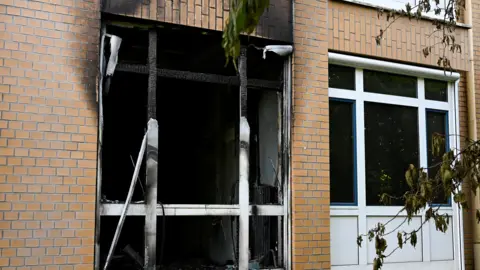A tragic incident occurred in Hamburg, Germany, where a fierce fire broke out in the elderly ward of the Marienkrankenhaus hospital. Reports indicate that three individuals lost their lives due to the inadequate accessibility for rescue operations amidst the chaos of the fire. The event unfolded shortly after midnight, casting a shadow over the otherwise calm night in the city as emergency services responded with vigor.
The Hamburg fire brigade worked tirelessly, deploying approximately 220 emergency personnel to manage the blaze and provide medical assistance to victims. Despite their best efforts, the rescue to save the three victims proved futile, as the fire had already engulfed the room by the time help arrived. The victims were reported to have died at the scene of the fire, marking a grim moment for the families and the local community.
In addition to the fatalities, the fire resulted in injuries to over 35 individuals. Among those affected, two patients required transfers to a different hospital due to the severity of their injuries; one of these patients is currently reported to be in a life-threatening condition. The fire brigade reported that 18 others suffered serious injuries, while an additional 15 individuals sustained minor wounds. Some of the injured received treatment in the hospital’s emergency room, offering a sense of community and support amidst the adversities of the situation.
Upon the arrival of the first responders, a ground-floor room of the hospital was already burning intensely, posing substantial risks to the patients located in the floors above. Many residents of the hospital expressed their distress to firefighters from their windows, informing them that they were unable to evacuate due to thick smoke filling the hallways. The Marienkrankenhaus is a four-story building, and the urgency of the situation necessitated immediate action to prevent further casualties.
Firefighters employed advanced equipment, including turntable and portable ladders, to rescue those trapped inside the building. The elderly patients, who typically face mobility challenges, were particularly vulnerable during the incident. Some patients were assisted through corridors using specialized fire escape hoods, enabling them to breathe in the smoke-logged environment. Thanks to the swift intervention of rescue teams, they were able to prevent the fire from spreading to additional areas of the hospital, though the cause of the blaze remains uncertain at this time.
In light of this catastrophe, local authorities and emergency workers are facing the immense task of assessing the situation thoroughly and determining what steps can be taken to prevent such incidents in the future. The heartbreak felt in Hamburg underscores the fragility of life and the need for comprehensive safety measures within healthcare facilities, particularly those designed to care for vulnerable populations like the elderly.
As the investigation into the incident unfolds, attention will be drawn not only to the immediate response but also to longer-term reforms that can improve fire safety and ensure that such tragedies do not recur. The loss of life in the Marienkrankenhaus fire is a poignant reminder of the potential dangers that exist in hospitals, which are typically seen as havens of safety.
In summary, the Hamburg hospital fire that led to three fatalities and numerous injuries highlights critical issues surrounding patient safety in healthcare environments. As the community mourns those lost, it becomes increasingly essential to place a focus on prevention and safety protocols in such facilities. The response of emergency services demonstrates both the challenges they face and the commendable efforts made under distressing circumstances, opening a dialogue regarding the future of safety in healthcare institutions.



